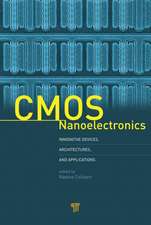Reuse Methodology Manual: For System-on-a-Chip Designs
Autor Pierre Bricauden Limba Engleză Paperback – 23 oct 2012
These designers see current design tools and methodologies as inadequate for developing million-gate ASICs from scratch. There is considerable pressure to keep design team size and design schedules constant even as design complexities grow. Tools are not providing the productivity gains required to keep pace with the increasing gate counts available from deep submicron technology. Design reuse - the use of pre-designed and pre-verified cores - is the most promising opportunity to bridge the gap between available gate-count and designer productivity.
Reuse Methodology Manual for System-On-A-Chip Designs, Second Edition outlines an effective methodology for creating reusable designs for use in a System-on-a-Chip (SoC) design methodology. Silicon and tool technologies move so quickly that no single methodology can provide a permanent solution to this highly dynamic problem. Instead, this manual is an attempt to capture and incrementally improve on current best practices in the industry, and to give a coherent, integrated view of the design process. Reuse Methodology Manual for System-On-A-Chip Designs, Second Edition will be updated on a regular basis as a result of changing technology and improved insight into the problems of design reuse and its role in producing high-quality SoC designs.
Preț: 389.31 lei
Nou
Puncte Express: 584
Preț estimativ în valută:
74.51€ • 80.43$ • 62.48£
74.51€ • 80.43$ • 62.48£
Carte tipărită la comandă
Livrare economică 19 aprilie-03 mai
Preluare comenzi: 021 569.72.76
Specificații
ISBN-13: 9781461372899
ISBN-10: 1461372895
Pagini: 316
Ilustrații: XXIII, 286 p.
Dimensiuni: 155 x 235 x 17 mm
Greutate: 0.45 kg
Ediția:2nd ed. 1999. Softcover reprint of the original 2nd ed. 1999
Editura: Springer Us
Colecția Springer
Locul publicării:New York, NY, United States
ISBN-10: 1461372895
Pagini: 316
Ilustrații: XXIII, 286 p.
Dimensiuni: 155 x 235 x 17 mm
Greutate: 0.45 kg
Ediția:2nd ed. 1999. Softcover reprint of the original 2nd ed. 1999
Editura: Springer Us
Colecția Springer
Locul publicării:New York, NY, United States
Public țintă
ResearchCuprins
1 Introduction.- 1.1 Goals of This Document.- 1.2 Design for Reuse: The Challenge.- 1.3 Design Reuse: A Business Model.- 2 The System-on-a-Chip Design Process.- 2.1 A Canonical SoC Design.- 2.2 System Design Flow.- 2.3 The Specification Problem.- 2.4 The System Design Process.- 3 System-Level Design Issues: Rules and Tools.- 3.1 The Standard Model.- 3.2 Design for Timing Closure: Logic Design Issues.- 3.3 Design for Timing Closure: Physical Design Issues.- 3.4 Design for Verification: Verification Strategy.- 3.5 System Interconnect and On-Chip Buses.- 3.6 Design for Low Power.- 3.7 Design for Test: Manufacturing Test Strategies.- 3.8 Prerequisites for Reuse.- 4 The Macro Design Process.- 4.1 Design Process Overview.- 4.2 Contents of a Design Specification.- 4.3 Top-Level Macro Design.- 4.4 Subb ock Design.- 4.5 Macro Integration.- 4.6 Soft Macro Productization.- 5 RTL Coding Guidelines.- 5.1 Overview of the Coding Guidelines.- 5.2 Basic Coding Practices.- 5.3 Coding for Portability.- 5.4 Guidelines for Clocks and Resets.- 5.5 Coding for Synthesis.- 5.6 Partitioning for Synthesis.- 5.7 Designing with Memories.- 5.8 Code Profiling.- 6 Macro Synthesis Guidelines.- 6.1 Overview of the Synthesis Problem.- 6.2 Macro Synthesis Strategy.- 6.3 High-Performance Synthesis.- 6.4 RAM and Datapath Generators.- 6.5 Coding Guidelines for Synthesis Scripts.- 7 Macro Verification Guidelines.- 7.1 Overview of Macro Verification.- 7.2 Inspection as Verification.- 7.3 Adversarial Testing.- 7.4 Testbench Design.- 7.5 Timing Verification.- 8 Developing Hard Macros.- 8.1 Overview.- 8.2 Design Issues for Hard Macros.- 8.3 The Hard Macro Design Process.- 8.4 Block Integration for Hard Macros.- 8.5 Productization of Hard Macros.- 8.6 Model Development for Hard Macros.- 8.7 Porting Hard Macros.- 9Macro Deployment: Packaging for Reuse.- 9.1 Delivering the Complete Product.- 9.2 Contents of the User Guide.- 10 System Integration with Reusable Macros.- 10.1 Integration Overview.- 10.2 Integrating Macros into an Soc Design.- 10.3 Selecting IP.- 10.4 Integrating Memories.- 10.5 Physical Design.- 11 System-Level Verification Issues.- 11.1 The Importance of Verification.- 11.2 The Verification Strategy.- 11.3 Interface Verification.- 11.4 Functional Verification.- 11.5 Application-Based Verification.- 11.6 Gate-Level Verification.- 11.7 Specialized Hardware for System Verification.- 12 Data and Project Management.- 12.1 Data Management.- 12.2 Project Management.- 13 Implementing a Reuse Process.- 13.1 Key Steps in Implementing a Reuse Process.- 13.2 Managing the Transition to Reuse.- 13.3 Organizational Issues in Reuse.- 13.4 Redesign for Reuse: Dealing with Legacy Designs.











